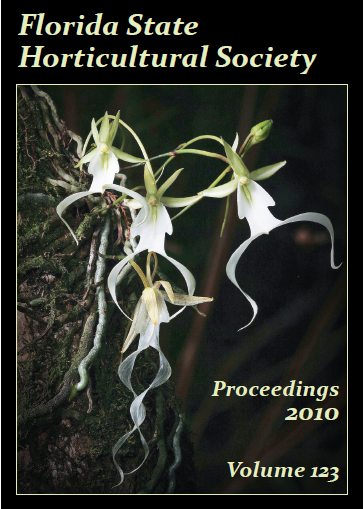Vegetable
Nutrient Management Programs for Fresh Market Tomatoes Grown with Plasticulture: Economic Insights
Published 2010-12-01
Keywords
- comprehensive crop budget,
- break-even price,
- best management practice,
- nitrogen,
- irrigation
Abstract
Fertilizer represents only a small portion of the total costs to grow fresh market tomatoes (Solanum lycopersicum L.). Therefore, growers may apply fertilizer rates in excess of UF/IFAS recommendations to prevent nutrient shortages and maintain productivity. With the adoption of BMPs to implement the TMDLs, growers are encouraged to follow UF/IFAS nutrient-irrigation recommendations. The objectives of this study were to 1) estimate the costs of UF/IFAS nutrient-irrigation management practices; 2) estimate total production costs with the UF/IFAS recommendations; and 3) calculate break-even prices. The estimated cost of UF/IFAS recommended nutrient-irrigation practices was $803.87/acre. Based on an estimated marketable yield of 1,500 25-lb tomato cartons/acre, the estimated production cost with UF/IFAS recommendations was $11,667.96/acre, and the break-even price for a 25-lb tomato carton was $7.78. The irrigation-fertilizer costs represented 4.41% and 2.48% of the total production costs, respectively. Upon doubling them, the fertilizer inputs represented an estimated 4.84% of the total production costs, and the break-even price increased by 19 cents to $7.97. Average prices of ‘U.S. One or Better’ grade tomatoes from 1998–2008 ranged between $7.88 and $14.76/25-lb carton, and the growers would have realized profits for 9 and 8 years with the UF/IFAS, and the growers’ high fertilizer input practices, respectively.References
- Cantliffe, D., P. Gilreath, D. Haman, C. Hutchinson, Y. Li, G. McAvoy, K. Migliaccio, T. Olczyk, S. Olson, D. Parmenter, B. Santos, S. Shukla, E. Simonne, C. Stanley, and A. Whidden. 2006. Review of nutrient management systems for Florida vegetable producers: A white paper from the UF/IFAS vegetable fertilizer task force. Proc. Fla. State Hort.Soc. 119:240–248.
- Duffy, M. and D. Smith. 2008. University Extension, Iowa State University. Estimated costs of crop production in Iowa—2008. 10 Dec. 2008. <http://www.extension.iastate.edu/agdm/crops/html/a1-20.html>.
- Florida Department of Agriculture and Consumer Services. 2005. Water quality/quantity best management practices for Florida vegetable and agronomic crops. Florida Department of Agriculture and Consumer Services, Office of Agricultural Water Policy. 7 Apr. 2008. <http://www.floridaagwaterpolicy.com/PDFs/BMPs/vegetable &agronomicCrops.pdf>.
- Gazula, A., E. Simonne, and B. Boman. 2007. Guidelines for enrolling in Florida’s BMP program for vegetable crops. Electronic Database Info. Syst., HS367, Univ. of Fla., Gainesville. 28 Feb. 2008. <http://edis.ifas.ufl.edu/pdffiles/HS/HS36700.pdf>.
- Hewitt, T. 2006. Estimated costs of producing one acre of tomatoes on plastic for fresh market, North Florida. North Florida Research and Education Center/University of Florida, 5 July 2010. <http://nfrec.ifas.ufl.edu/programs/enterprise_budgets.shtml>.
- Kelly,T.C., Y.C. Lu, A.A. Abdul-Baki, and J.R. Teasdale. 1995. Economics of a hairy vetch mulch system for producing fresh-market tomatoes in the mid-Atlantic region. J. Amer. Soc Hort. Sci. 120:854–860.
- Muraro, R.P., F. Roka, and R.E. Rouse. 2005. Budgeting costs and returns for Southwest Florida citrus production, 2002–03. Electronic Database Information System, FE434, Univ. of Fla., Gainesville, FL. 28 Feb. 2008. <http://edis.ifas.ufl.edu/pdffiles/FE/FE43400.pdf>.
- Olson, S.M., W.M. Stall, M.T. Momol, S.E. Webb, T.G. Taylor, S.A. Smith, E.H. Simonne, and E. McAvoy. 2007. Tomato production in Florida. Electronic Database Info. Syst., HS739, Univ. of Fla., Gainesville, FL. 28 Feb. 2008. <http://edis.ifas.ufl.edu/pdffiles/CV/CV13700.pdf>
- Pitts, D.J., A.G. Smajstrla, D.Z. Haman, and G.A. Clark. 2002. Irrigation costs for tomato production in Florida. Electronic Database Information System, HS367, Univ. of Fla., Gainesville. 28 Feb. 2008. <http://edis.ifas.ufl.edu/pdffiles/AE/AE01000.pdf>.
- Sargent, S.A., J.K. Brecht, and T. Olczyk. 2005. Handling Florida vegetables series—Round and Roma tomato types. Electronic Database Info. Syst., SS-VEC-928. Univ. of Fla., Gainesville, FL. 02 Mar. 2008. <http://edis.ifas.ufl.edu/pdffiles/VH/VH07900.pdf>.
- Simonne, E.H., M.D. Dukes and D.Z. Haman. 2007. Principles and practices of irrigation management for vegetables. Electronic Database Info. Syst., AE260. Univ. of Fla., Gainesville. 02 Mar. 2008. <http://edis.ifas.ufl.edu/pdffiles/CV/CV10700.pdf>
- Sydorovych, O., C.D. Safley, R.M. Welker, L.M. Ferguson, D.W. Monks, K. Jennings, J. Driver, and F.J. Louws. 2008. Economic evaluation of methyl bromide alternatives for the production of tomatoes in North Carolina. HortTechnology 18:705–713.
- United States Congress. 1977. Clean Water Act. PL 95-217, 27 Dec., vol. 91, pp.1566–1611. US Statutes At Large, US Government Printing Office, Washington, DC.
- United States Department of Agriculture–National Agricultural Statistics Service. 2008. Agricultural statistics data base. 8 Dec. 2008. <http://www.nass.usda.gov/QuickStats/Create_Federal_All.jsp >

